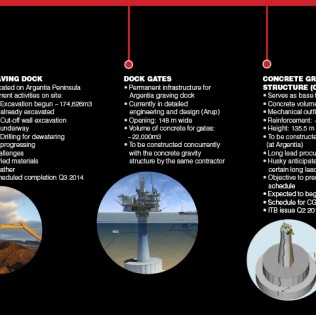by TheOGM
| No comment
Published on April 3rd, 2013
The First True 3D Marine Seismic System
Since their introduction in the 1980s, multi-streamer marine 3D seismic surveys have been widely recognized as a key enabler for increasing drilling success rates during the exploration and development of offshore oil and gas fields. Today, these surveys are typically acquired by a vessel equipped with between 8 and 16 streamers towed 50 to 100 m apart, each 3 to 8 km long. Each streamer contains hydrophone sensors, and spatial sampling of the data recorded along each streamer (inline) can be as fine as 3.125 m; however, the much greater distance between adjacent streamers means that sampling in the crossline direction can be 16–32 times sparser. Such coarsely sampled data cannot capture the whole 3D wavefield, which limits its ability to accurately image the subsurface. While developments in seismic sources and sensors have improved the frequency bandwidth that can be input to the subsurface and subsequently recorded back at the surface, achieving truly 3D high-resolution images of complex subsurface structures also requires adequate spatial sampling in both the inline and crossline directions.
In 2012, WesternGeco announced the launch of its IsoMetrix* marine seismic technology, which for the first time enables true measurement of 3D seismic wavefields recorded using towed streamers. This capability is the result of an extensive ten-year research and engineering program that has been the largest single engineering project ever undertaken by Schlumberger, the world’s leading provider of oilfield services. The new technology delivers high-fidelity point-receiver seismic data while overcoming spatial wavenumber bandwidth compromises that have limited previous marine seismic acquisition methods. The result is a reliable, continuous measurement of the full upgoing and downgoing notchless seismic wavefield sampled at a 6.25 m x 6.25 m point-receiver surface grid. This fine isometric sampling in both crossline and inline directions makes the data suitable for use in a wide variety of interpretation and modeling applications, such as high-resolution near-surface imaging, deep reservoir characterization, and 4D reservoir monitoring.
Isometric 3D sampling is enabled by the Nessie-6* point-receiver streamer system. This incorporates a new generation towed streamer design that combines measurements of wavefield pressure and gradient—vertically and crossline. It uses point-receiver technology that combines hydrophones with calibrated point-receiver microelectromechanical system (MEMS) accelerometers that measure the full particle acceleration of the upgoing and downgoing seismic wavefield. Direct measurement of the vertical and crossline gradient enables unaliased reconstruction of the pressure wavefield between the streamers.
A new computer algorithm—which has been shown to be extremely robust in dealing with highly aliased data—performs simultaneous spatial reconstruction and receiver deghosting of the seismic pressure wavefield. The source ghost is addressed by the WesternGeco newly developed Delta calibrated marine broadband seismic source family of notchless seismic sources. The algorithm can compute the upgoing and downgoing separated wavefield at any desired position within a spread of streamers. This ability contributes to an unmatched level of repeatability in 4D (time-lase) projects, which map subtle changes in the seismic response of a reservoir related to changes in pressure or fluid content. The method can guide reservoir management decisions, identify flow barriers, and locate untapped compartments suitable for infill drilling. “We have developed a new category of seismic that not only includes the acquisition technology, but also the algorithms and workflows needed to manage such an unprecedented amount of data,” said Carel Hooykaas, president, WesternGeco, at the launch of the IsoMetrix system during the European Association of Geoscientists and Engineers (EAGE) 2012 annual conference and exhibition. “The step change in imaging is as profound as was the move from X-rays to full 3D scans in the world of medicine.”
During August 2012, the 3D seismic vessel Western Pride, deploying eight full-length streamers in the North Sea, completed acquisition of its first commercial project on schedule. During September, commercial surveys were acquired for two other operators. The new technology has proved to be very robust during operations and is attracting considerable interest from oil and gas exploration and production companies of all sizes around the world.
In February 2013, the seismic vessel WG Vespucci (pictured), equipped with 10 full length streamers, completed acquisition using IsoMetrix technology of a 3D survey for Thombo Petroleum Ltd. The survey covered a full fold area of 686 km2 extending over the A‐J1 graben of Block 2B located off the west coast of South Africa. This graben contains the A‐J1 oil discovery drilled and tested by Soekor in 1988. The new data will allow Thombo and its partner Afren plc to evaluate in detail not only the extent of the A‐J1 oil discovery but also the many other prospects and leads in the graben that have been identified from existing 2D seismic data. WG Vespucci is embarked on a busy schedule of IsoMetrix projects around the world and other vessels will soon be fitted with the new equipment.
Stuart Papworth is IsoMetrix Business Manager for WesternGeco
*Mark of Schlumberger
Top: WG Vespucci is one of the first vessels in the WesternGeco seismic fleet acquiring commercial 3D surveys using IsoMetrix technology. (Image courtesy of WesternGeco)
Did you enjoy this article?

 Intecsea & WorleyParsons - Expanding Operations In Atlantic Canada
Intecsea & WorleyParsons - Expanding Operations In Atlantic Canada White Rose Extension
White Rose Extension Surveying The Road To Project Success
Surveying The Road To Project Success What is Best-in-Class in Contractor Management?
What is Best-in-Class in Contractor Management? Basin Hunters
Basin Hunters
